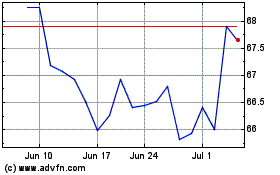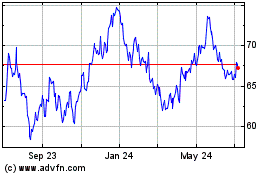Glencore Shares Hit New Low -- Update
September 15 2015 - 10:02AM
Dow Jones News
By Alex MacDonald and Josie Cox
LONDON-- Glencore PLC shares hit a new low Tuesday, reversing
last week's gains as coal prices fell and investors became fretful
about the company's debt-rescue plan.
Shares in the Swiss commodities trader and producer fell nearly
8% to an intraday low of 118 pence before paring back some of the
losses to 123 pence by midafternoon European trade, still down more
than 3%. The rest of the U.K. mining sector also fell, with the
FTSE 350 mining index down 1.4% and other large miners such as Rio
Tinto PLC and BHP Billiton PLC down 1.3% and 1.4% respectively.
Glencore's stock is the worst performer in the U.K.'s blue-chip
FTSE 100 index so far this year. The company's shares have fallen
nearly 60% since the beginning of the year and more than three
quarters since its London share listing in 2011.
The reason: a continued collapse in a basket of commodities
prices including copper and coal, two of its most important
earnings drivers. The company has also been hit by growing
uncertainty about the timing and structure of the proposed equity
issue of up to $2.5 billion as it seeks to pay down debt and stave
off a potential credit-rating downgrade.
Glencore announced last week $10 billion worth of measures aimed
at cutting its net debt by a third to around $20 billion by the end
of 2016. This helped boost the company's shares.
But with Glencore's share price continuing to fall, some
analysts say the company may need to issue more shares to raise
funds.
"The more the share price drops, the more dilutive [issuing new
stock] becomes. They will have to issue more shares to achieve the
same level of funding," said Carole Ferguson, an equity analyst at
advisory firm SP Angel.
A Glencore spokesman declined to comment.
Glencore has also been troubled by some of its biggest bets not
panning out. The commodities rout has raised new concerns about
Chief Executive Ivan Glasenberg's decision to acquire Anglo-Swiss
miner Xstrata PLC for $29.5 billion, taking Glencore away from its
trading house roots.
The purchase catapulted Glencore into the mining big league,
making it the world's largest thermal coal exporter and largest
copper supplier. Since then prices for those two commodities, and
several others, have fallen to multiyear lows due to
weaker-than-expected demand from China, the world's largest
consumer of those commodities, and excess supply.
Copper dropped to a more than six-year low last month.
The benchmark thermal coal prices in South Africa and the
Netherlands were hovering at $51.95 a metric ton and $50.90 a ton
respectively on Tuesday, a multiyear low since the onset of the
financial crisis in 2008. A third benchmark thermal coal price in
Australia was hovering at $57.65 a ton, down 6.9% this year.
A general malaise is affecting the entire mining sector,
analysts say. There is an oversupply of materials like iron ore and
copper, and demand from China appears to be slowing as the giant
consuming nation experiences new economic difficulties.
"In the short term the [mining] sector will certainly remain
volatile, and looking at the fundamentals it seems to us that
further downside risk could emerge," said Viviane Ting, equity
analyst at Amundi Asset Management in a note to clients on Tuesday.
"It will take some time before new demand sources take over from
the decelerating domestic demand trend from China."
In the longer term, however, she said she expects the sector to
improve, because of increasing commodity demand from countries like
India.
Write to Alex MacDonald at alex.macdonald@wsj.com and Josie Cox
at josie.cox@wsj.com
Subscribe to WSJ: http://online.wsj.com?mod=djnwires
(END) Dow Jones Newswires
September 15, 2015 09:47 ET (13:47 GMT)
Copyright (c) 2015 Dow Jones & Company, Inc.
Rio Tinto (NYSE:RIO)
Historical Stock Chart
From Mar 2024 to Apr 2024

Rio Tinto (NYSE:RIO)
Historical Stock Chart
From Apr 2023 to Apr 2024
